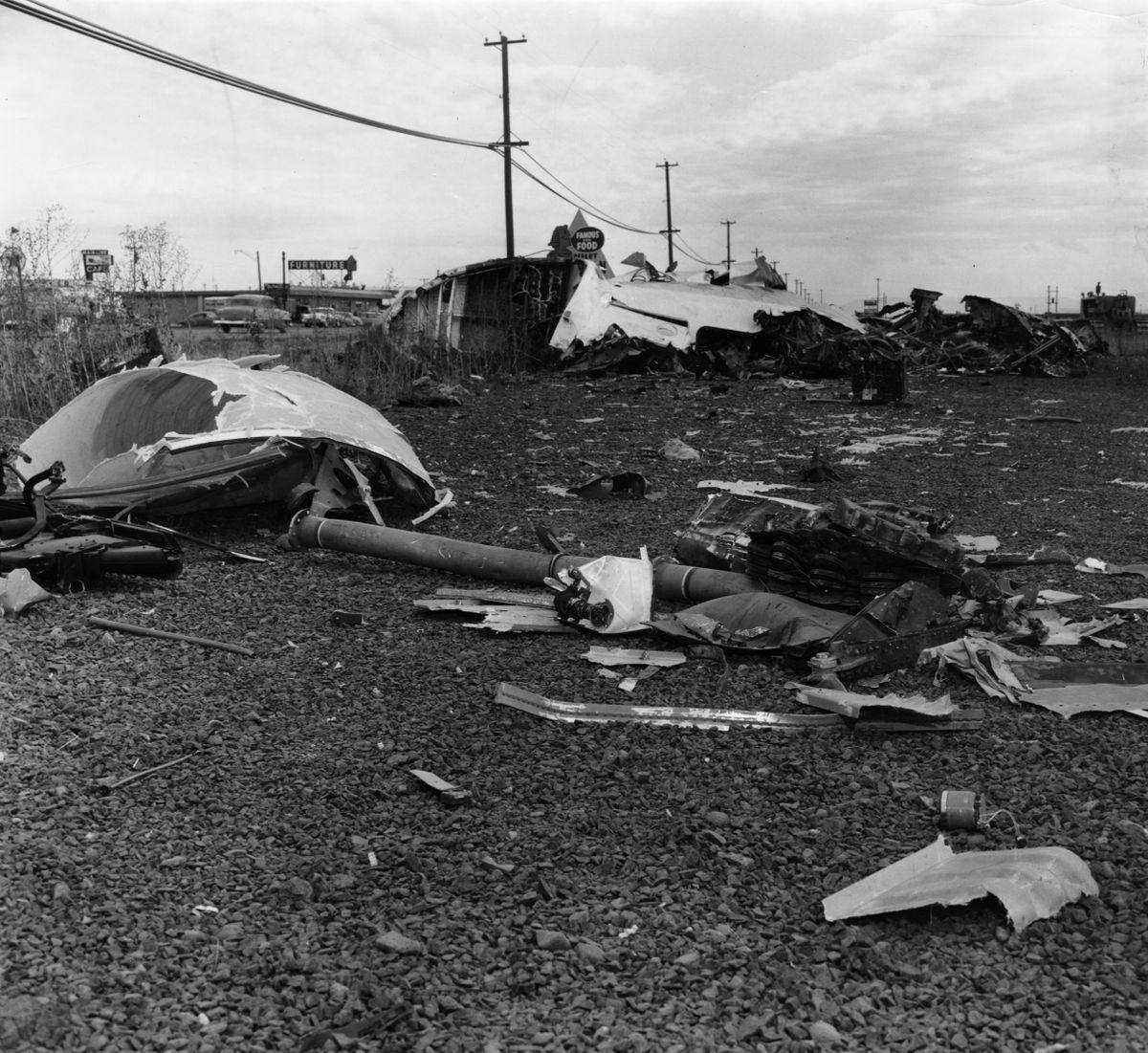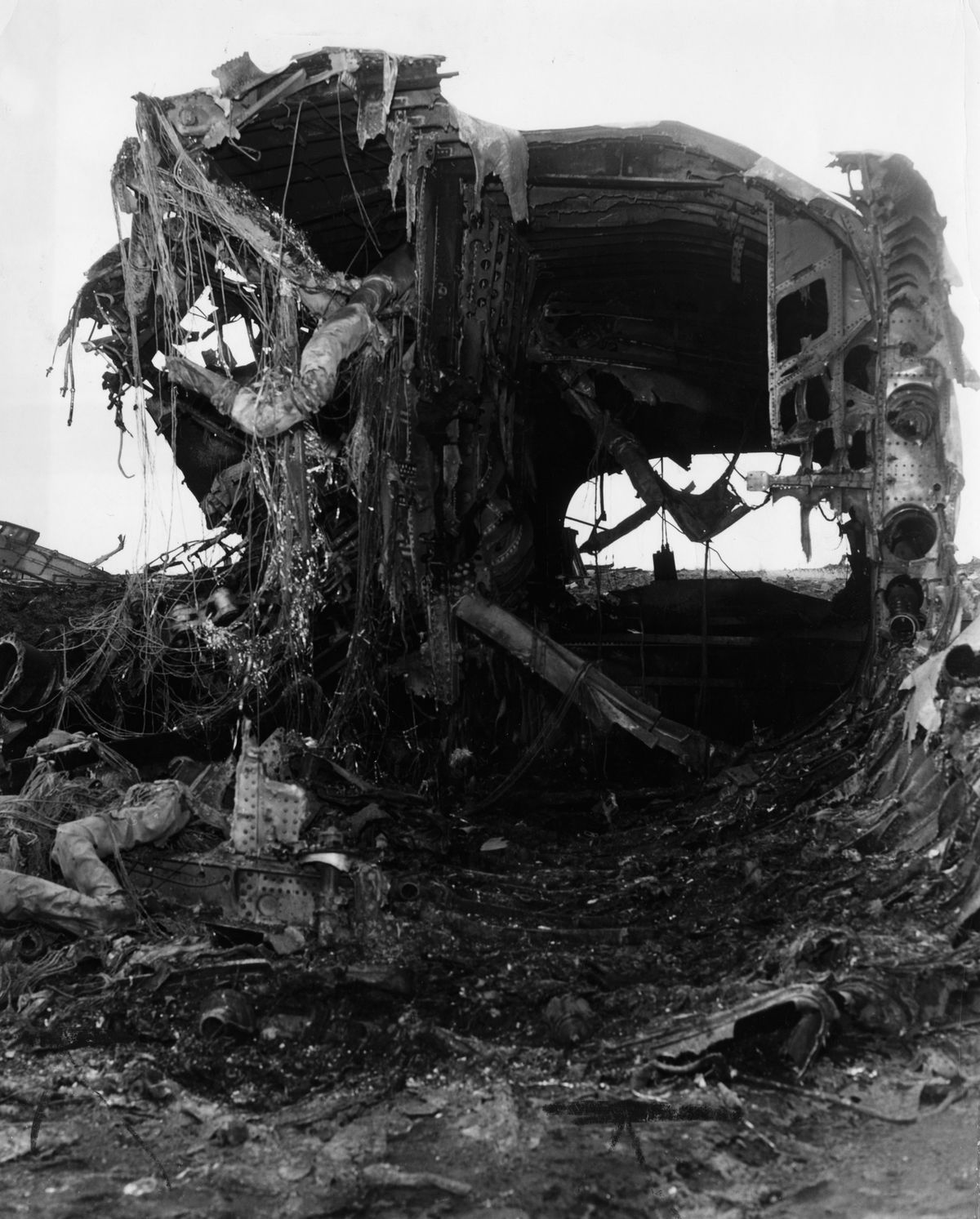Witnesses recall B-52 collision
1958 Fairchild training accident left 12 dead
B-52 wreckage is strewn across a field after a collision near Fairchild Air Force Base on Sept. 9, 1958. (File / The Spokesman-Review)
Helen Hodsdon was getting dinner that evening 50 years ago when her husband, Ed, yelled to come outside of their house in Airway Heights.
There were two B-52s in the sky, and Ed Hodsdon, a gunner on the big bombers stationed at nearby Fairchild Air Force Base, knew something wasn’t right.
Down Sunset Highway at the Shell station, Joe Martella looked up from the gas pump where he was filling a customer’s car and had the same feeling. Two B-52s in the sky wasn’t unusual – the nation’s newest bombers had been at Fairchild for more than a year, and they routinely practiced landings and takeoffs on the base runway.
But Martella, who’d been an anti-aircraft gunner in the Army a few years earlier, was sure the two planes were dangerously close.
He ran into the office where the station’s owner, his uncle Mike Anderson, and some other people were. “I yelled, ‘Get the hell out, and run.’ They looked at me like I was crazy.”
Then there was an explosion. The planes became “nothing but a ball of fire,” Helen Hodsdon said.
On that late summer evening, a half-century ago on Monday, two big bombers collided in the skies over Airway Heights, causing one of Fairchild’s worst accidents and raining pieces of the giant planes down on what was then a community of about 200 residents.
Lea Ziegler, then a 15-year-old high school student, heard the explosion and jumped off his back porch, where he’d been working on a model airplane engine. He looked up to see two bombers careening toward the ground.
“It was like slow motion,” Ziegler said recently. “One had flipped over … the other was just coming down.”
The wing of one bomber had sliced off the cockpit of the other, and the severed front portion of that plane – with crew members still in it – landed near the highway not far from the small city hall building and caught fire. The intact plane was tilting toward the Buckhorn Tavern but kept tilting and crashed in the field behind it.
Martella, Anderson and others at the service station ran when the planes exploded. Anderson would tell The Spokesman-Review the next morning his legs had charley horses from running so fast.
The heat was intense, Martella recalled recently. “You could feel it on your back; it was that close.”
A piece of landing gear sheared off the Shell station sign, near where Martella had parked his new car. The landing gear hit near the car, flipped over it and stuck in the other side. The windshield broke, and the car was splattered with hydraulic fuel.
Other pieces, some as large as the bombers’ tail sections, landed in surrounding wheat and barley fields. Pieces of metal and ball bearings showered roofs in the community, Helen Hodsdon said.
The two planes were carrying a total of 16 men for their practice missions. Four parachuted or fell into the fields after the midair collision. The other 12 were killed either by the collision or when the planes, or their severed parts, hit the ground and burned. Jet fuel ignited. Magnesium parts flared.
Fire crews from the base and surrounding communities responded to the calls. So did the State Patrol and other law enforcement officers, who directed traffic and controlled the crowds.
One of those who parachuted was badly burned and died later that night in the base hospital, but three – Capt. David Birdsell, a pilot; Lt. Walter Maguire, an electronic weapons officer; and Staff Sgt. Lowell Younger, a tail gunner – survived.
The Rev. Howard Lanphear, of the Airway Heights Community Church, was among the first to reach Younger, who was walking across the field with his helmet in one hand and oxygen mask in the other. Lanphear told a newspaper reporter that Younger apparently hit his head in ejecting but didn’t complain of any injury or pain, saying merely, “I thought that tail cone would never let go.”
Ziegler looked up to see a life raft, thrown from one of the planes, inflated on his roof.
“It was about the size of a small pool,” he said, and would be great for taking on the water with his buddies. About that time, he saw someone in an Air Force uniform climb up on the roof, pull down the raft and haul it away.
The Air Force would later put out a call to residents and spectators to please not pick up plane parts as souvenirs because they were needed for the investigation. Base personnel walked across the fields, practically arm in arm, looking for parts, Hodsdon said.
About two months later, a panel of investigators announced its conclusion: Basic flight procedures hadn’t been followed. The two bombers were practicing landing and takeoff maneuvers that included using instrument rules for parts of their flights and visual rules for other parts. The B-52 closer to the runway had just switched off its instrument maneuvers the B-52 farther away had not yet switched on its instruments. The control tower didn’t pick up the more distant B-52 until it was about three miles from the runway, when the closer bomber was on its final approach. The tower ordered the first plane to go up and to the right – a standard breakaway maneuver – while the closer one should have followed procedures to go down and to the left, to land. Instead, both planes pulled up and to the right, and into each other. The official report never explained why the plane closer to the runway didn’t follow standard procedures, The Spokesman-Review noted when it was released in November 1958.
For several days after the crash, Sunset Highway was closed and traffic routed past the Hodsdons’ home on 13th Street. Ed died in 2007, but Helen still lives in the same Airway Heights home they had when she was a young Air Force wife.
Although uniformed personnel had scoured the crash sites, Ziegler said, he and his friends went out and picked up small pieces of aluminum. They found about 80 pounds, he recalled.
“I bet if you walk through those fields you’d still find pieces of metal,” said Ziegler, who lives in Spokane.
Two survivors, Younger and Maguire, eventually were transferred to other bases. Birdsell, who fell some 200 feet to the ground when his parachute didn’t open, spent more than a year and a half in the hospital. He eventually left the Air Force, went back to college, earned a degree and became a teacher. He taught for 22 years at local high schools. When he retired from teaching in 1986, he told a Spokesman-Review reporter he had no memory of the crash.
“I don’t even remember leaving home to go fly,” he said at the time. Birdsell died in 1994.
Martella said he saw Birdsell from time to time and knew his body was full of screws and wires from being pieced back together after the crash. But Birdsell never complained, and the only sign of his injuries was that one of his legs was shorter than the other, so he wore a built-up shoe. Martella stayed in Airway Heights, owned a tavern on Sunset Highway for years and eventually was elected mayor.
Fifty years later, the B-52s are gone from Fairchild – they left in 1994 as part of an Air Force reorganization – and apparently no one remains who remembers that crash. The base averaged about one crash a year in the first decade it served as a home for nuclear-equipped bombers, although the 1958 incident was one of the biggest for the entire Strategic Air Command.
Martella said he called recently to ask if the base had any plans to commemorate the crash of a half century ago and was told to “call the newspaper.”
He did; because, he said, someone should remember.

